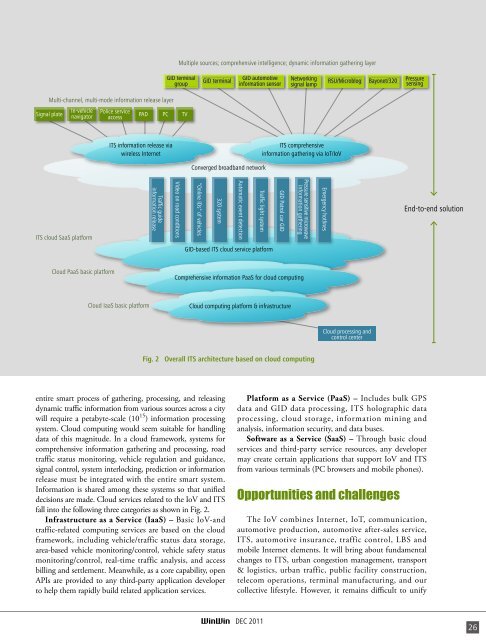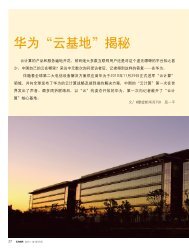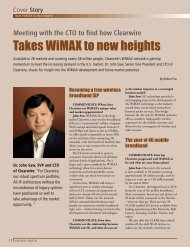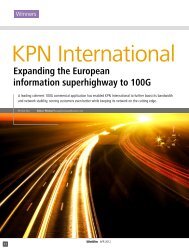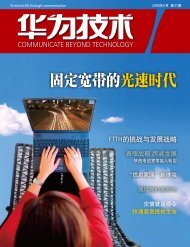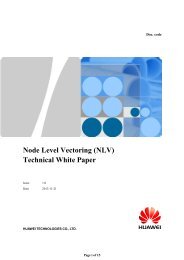Telekom Malaysia - Huawei
Telekom Malaysia - Huawei
Telekom Malaysia - Huawei
You also want an ePaper? Increase the reach of your titles
YUMPU automatically turns print PDFs into web optimized ePapers that Google loves.
Multiple sources; comprehensive intelligence; dynamic information gathering layer<br />
Multi-channel, multi-mode information release layer<br />
Signal plate<br />
In-vehicle<br />
navigator<br />
Police service<br />
access<br />
PAD PC TV<br />
ITS information release via<br />
wireless Internet<br />
ITS comprehensive<br />
information gathering via IoT/IoV<br />
Converged broadband network<br />
ITS cloud SaaS platform<br />
Traffic guide<br />
information release<br />
Video on road conditions<br />
Traffic light system<br />
Automatic event detection<br />
320 system<br />
"Online IDs" of vehicles<br />
GID Patrol car GID<br />
Pressure sensitive microwave<br />
information gathering<br />
Emergency hotlines<br />
End-to-end solution<br />
GID-based ITS cloud service platform<br />
Cloud PaaS basic platform<br />
Comprehensive information PaaS for cloud computing<br />
Cloud IaaS basic platform<br />
Cloud computing platform & infrastructure<br />
Cloud processing and<br />
control center<br />
Fig. 2 Overall ITS architecture based on cloud computing<br />
entire smart process of gathering, processing, and releasing<br />
dynamic traffic information from various sources across a city<br />
will require a petabyte-scale (10 15 ) information processing<br />
system. Cloud computing would seem suitable for handling<br />
data of this magnitude. In a cloud framework, systems for<br />
comprehensive information gathering and processing, road<br />
traffic status monitoring, vehicle regulation and guidance,<br />
signal control, system interlocking, prediction or information<br />
release must be integrated with the entire smart system.<br />
Information is shared among these systems so that unified<br />
decisions are made. Cloud services related to the IoV and ITS<br />
fall into the following three categories as shown in Fig. 2.<br />
Infrastructure as a Service (IaaS) – Basic IoV-and<br />
traffic-related computing services are based on the cloud<br />
framework, including vehicle/traffic status data storage,<br />
area-based vehicle monitoring/control, vehicle safety status<br />
monitoring/control, real-time traffic analysis, and access<br />
billing and settlement. Meanwhile, as a core capability, open<br />
APIs are provided to any third-party application developer<br />
to help them rapidly build related application services.<br />
Platform as a Service (PaaS) – Includes bulk GPS<br />
data and GID data processing, ITS holographic data<br />
processing, cloud storage, information mining and<br />
analysis, information security, and data buses.<br />
Software as a Service (SaaS) – Through basic cloud<br />
services and third-party service resources, any developer<br />
may create certain applications that support IoV and ITS<br />
from various terminals (PC browsers and mobile phones).<br />
Opportunities and challenges<br />
The IoV combines Internet, IoT, communication,<br />
automotive production, automotive after-sales service,<br />
ITS, automotive insurance, traffic control, LBS and<br />
mobile Internet elements. It will bring about fundamental<br />
changes to ITS, urban congestion management, transport<br />
& logistics, urban traffic, public facility construction,<br />
telecom operations, terminal manufacturing, and our<br />
collective lifestyle. However, it remains difficult to unify<br />
DEC 2011<br />
26


